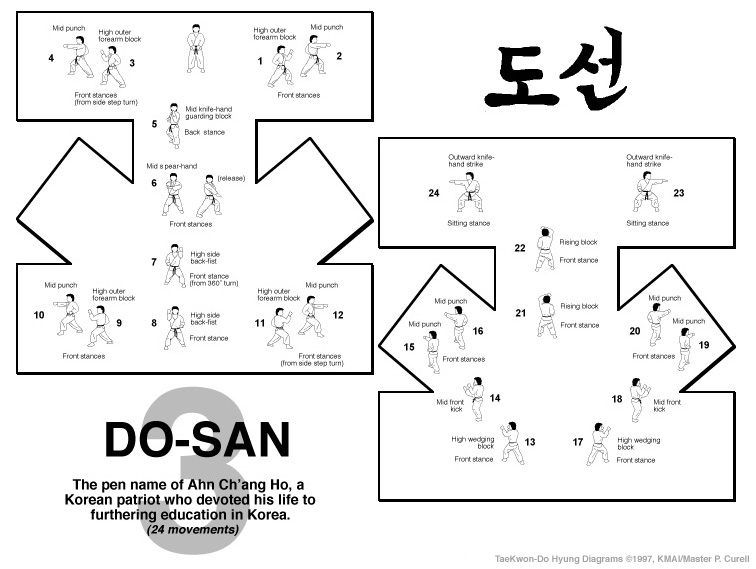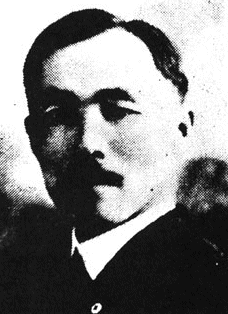|
|||
|
| -Countries |
| -Dictionary |
| -Federations |
| -M.A. Timeline |
| -Number System |
| -Styles |
| -Weapons |
| -Who's Who |
| -Updates |
| -Credits |
| -Stats |
| -Webmaster |
| To-San
The pattern Do-San consists of 24 movements and is named for Do-San, the pseudonym of the Korean patriot An Chang-Ho (1878-1938). Throughout his life, An Chang-Ho was a driving force in the Korean Independence Movement. To understand the significance of An Chang-Ho's achievements, one must understand the oppressive climate throughout the Korean peninsula during the Japanese occupation (1904-1945). During this occupation an effort was made to eradicate the Korean culture, literature historical records, and education. As a result of this oppression, many refugees fled to China, Manchuria, the United States, and other countries. Among the first koreans to emigrate to the United States in 1903 were An Chang-Ho and Rhee Syngman who was later to become the first president of the Republic of Korea. Once in the United States, An Chang-Ho established groups within the Korean community in support of the independence of the Korean people. Similar groups were simultaneously being organized in other countries by other Korean patriots. Religious organizations from various countries lent valuable assistance to these groups. In 1907 An Chang-Ho returned to Korea to establish the Sinminhoe (New People's Society), a secret independence group in Pyong-An Province. The Sinminhoe was associated with Protestant organizations and supported a youth group and a school. The organization was dedicated to promoting the recovery of Korean independence through the cultivation and emergence of nationalism in education, business, and culture. In 1908 the Sinminhoe established the Taesong (large Achievement) School to provide Korean youth with an education based on national spirit. The political environment of the time, however, was not conducive to the founding of such a school: the Japanese were in the process of actively banning education for Koreans. By denying the Korean children proper schooling, the Japanese wanted to ensure their illiteracy, thus essentially creating a class of slave workers. By 1910 the Sinminhoe had around 300 members and represented a threat to the occupation. The Japanese were actively crushing these types of organizations, and the Sinminhoe quickly became a target of their efforts. An opportunity to break up the Sinrninhoe soon presented itself. In December of 1910 the Japanese governor general, Terauchi, was scheduled to attend the dedicating ceremony for the new railway bridge over the Amnok River. The Japanese used this situation to pretend to uncover a plot to assassinate Terauchi on the way to this ceremony. All of the Sinminhoe leaders and 600 innocent Christians were arrested. Under severe torture, which led to the deaths of many, 105 Koreans were indicted and brought to trial. During the trial, however, the defendants were adamant about their innocence. The world community felt that the alleged plot was such an obvious fabrication that political pressure grew, and most of the defendants had to be set free. By 1913 only six of the original defendants had received prison sentences. By this time, the Japanese had become fairly successful at detecting and destroying underground resistance groups. They were not at all successful, however, in quelling the desire for freedom and self-government among the Korean people. The resistance groups moved further underground and guerilla raids from the independence groups in Manchuria and Siberia increased. The Japanese stepped up their assault on the Korean school system and other nationalistic movements. After the passage of an Education Act in 1911 the Japanese began to close all Korean schools. In 1913 the Taesong School was forced to close, and by 1914 virtually all Korean schools had been shut down. This all but completed the Japanese campaign of cultural genocide. Chances of any part of the Korean culture surviving rested in the hands of the few dedicated patriots working in exile outside of Korea. By the end of World War 1, one of these freedom fighters, An Chang-Ho, had returned to the United States with Rhee Syng man. There, Rhee had organized he Tongjihoe (Comrade Society) in Honolulu and An Chang-Ho had formed the Kungminhoe (People's Society) in Los Angeles. Through these and other organizations an attempt was made to pressure President Woodrow Wilson into speaking in behalf of Korean autonomy at the Paris peace talks. Finally, in 1918, a representative of the Korean exiles was sent to these peace talks. In 1919 Rhee Syngman, An Chang-Ho, and Kim Ku set up a in Shanghai. They drew up a Democratic Constitution that provided for a freely elected president and legislature. This document also established the freedom of the press, speech, religion, and assembly. An independent judiciary was established and the previous class system of nobility was abolished. Finally, on March 1, 1919, the provisional government declared its independence from Japan and called for general resistance from the Korean population. During the resistance demonstrations the Japanese police opened fire on the unarmed Korean crowds, killing thousands. Many thousand more were arrested and tortured. Even after the Korean Declaration of Independence, An Chang-Ho continued his efforts in the United States on behalf of his homeland. In 1922, he headed a historical commission to compile all materials related to Korea, especially the facts concerning the Japanese occupation. Korean culture owes much to An Chang-Ho. His dedication to the education of the Korean people and to the protection of its culture was vital curing a time when the Japanese were attempting to eradicate Korean culture and independence. |
||||||||||||||||||||||||||||||||||||||||||||||||||||


 He
was particularly committed to preserving the Korean educational
system during the Japanese occupation, and he was well known
for sincerity and lack of pretense in dealing with others.
He
was particularly committed to preserving the Korean educational
system during the Japanese occupation, and he was well known
for sincerity and lack of pretense in dealing with others.